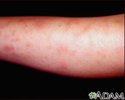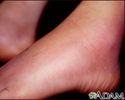Erythema nodosum
Erythema nodosum is an inflammatory disorder. It involves tender, red bumps ( nodules ) under the skin.
Nodules
Skin nodules are solid or cystic raised bumps in the skin that are wider than 1 centimeter (cm), but less than 2 cm.

Causes
In about half of cases, the exact cause of erythema nodosum is unknown.
Some cases may occur with infections. Some of the more common infections are:
- Streptococcus (most common)
- Cat scratch disease
- Chlamydia
-
Coccidioidomycosis
Coccidioidomycosis
Valley fever is an infection that occurs when the spores of the fungus Coccidioides immitis enter your body through the lungs.
 ImageRead Article Now Book Mark Article
ImageRead Article Now Book Mark Article - Hepatitis B
-
Histoplasmosis
Histoplasmosis
Histoplasmosis is an infection that occurs from breathing in the spores of the fungus Histoplasma capsulatum.
 ImageRead Article Now Book Mark Article
ImageRead Article Now Book Mark Article -
Leptospirosis
Leptospirosis
Leptospirosis is an infection. It occurs when you come in contact with leptospira bacteria.
 ImageRead Article Now Book Mark Article
ImageRead Article Now Book Mark Article -
Mononucleosis
(EBV)
Mononucleosis
Mononucleosis, or mono, is a viral infection that causes fever, sore throat, and swollen lymph glands, most often in the neck.
 ImageRead Article Now Book Mark Article
ImageRead Article Now Book Mark Article - Mycobacteria
- Mycoplasma
-
Psittacosis
Psittacosis
Psittacosis is an infection caused by Chlamydophila psittaci, a type of bacteria found in the droppings of birds. Birds spread the infection to huma...
 ImageRead Article Now Book Mark Article
ImageRead Article Now Book Mark Article - Syphilis
-
Tuberculosis
Tuberculosis
Pulmonary tuberculosis (TB) is a contagious bacterial infection that involves the lungs. It may spread to other organs.
 ImageRead Article Now Book Mark Article
ImageRead Article Now Book Mark Article -
Tularemia
Tularemia
Tularemia is a bacterial infection common in wild rodents. The bacteria are passed to humans through contact with tissue from the infected animal. ...
 ImageRead Article Now Book Mark Article
ImageRead Article Now Book Mark Article - Yersinia
Erythema nodosum may occur with sensitivity to certain medicines, including:
- Antibiotics, including amoxicillin and other penicillins
- Sulfonamides
- Sulfones
- Birth control pills
- Progestin
Sometimes, erythema nodosum may occur during pregnancy.
Other disorders linked to this condition include leukemia, lymphoma, sarcoidosis, rheumatic fever , Bechet disease, and ulcerative colitis .
Rheumatic fever
Rheumatic fever is a disease that may develop after an infection with group A streptococcus bacteria (such as strep throat or scarlet fever). It can...
Ulcerative colitis
Ulcerative colitis is a condition in which the lining of the large intestine (colon) and rectum become inflamed. It is a form of inflammatory bowel ...

The condition is more common in women than it is in men.
Symptoms
Erythema nodosum is most common on the shins. It may also occur on other areas of the body such as buttocks, calves, ankles, thighs, and arms.
The lesions begin as flat, firm, hot, red, painful lumps that are about 1 inch (2.5 centimeters) across. Within a few days, they may become purplish in color. Over several weeks, the lumps fade to a brownish, flat patch.
Other symptoms may include:
- Fever
- General ill feeling (malaise)
- Joint aches
- Skin redness, inflammation, or irritation
- Swelling of the leg or other affected area
Exams and Tests
Your doctor can diagnose this condition by looking at your skin. Tests that may be done include:
-
Punch biopsy
of a nodule
Punch biopsy
A skin lesion biopsy is when a small amount of skin is removed so it can be examined. The skin is tested to look for skin conditions or diseases. A...
 ImageRead Article Now Book Mark Article
ImageRead Article Now Book Mark Article - Throat culture to rule out a strep infection
- Chest x-ray to rule out sarcoidosis or tuberculosis
Treatment
The underlying infection, drug, or disease should be identified and treated.
Treatment may include:
- Nonsteroidal anti-inflammatory drugs (NSAIDs) to reduce pain and swelling.
- Stronger anti-inflammatory medicines called steroids, taken by mouth or given as a shot.
- Potassium iodide (SSKI) solution to clear up the nodules.
-
Salicylate medicines to reduce
acute
inflammation.
Acute
Acute means sudden or severe. Acute symptoms appear, change, or worsen rapidly. It is the opposite of chronic.
 ImageRead Article Now Book Mark Article
ImageRead Article Now Book Mark Article - Pain medicines (analgesics).
- Rest.
- Raising the sore area (elevation).
- Hot or cold compresses to help reduce discomfort.
Outlook (Prognosis)
Erythema nodosum is uncomfortable, but not dangerous in most cases.
Symptoms most often go away within about 6 weeks, but may return.
When to Contact a Medical Professional
Call your health care provider if you develop symptoms of erythema nodosum.
References
Ferri FF. Erythema nodosum. In: Ferri FF, ed. Ferri's Clinical Advisor 2016 . Philadelphia, PA: Elsevier; 2016:486-486.
Schwartz RA, Nervi SJ. Erythema nodosum: a sign of systemic disease. Am Fam Physician . 2007;75(5):695-700. PMID: 17375516 www.ncbi.nlm.nih.gov/pubmed/17375516 .
-
Erythema nodosum associated with sarcoidosis - illustration
This picture shows reddish-purple, hard (indurated), painful nodules (Erythema nodosum) that occur most commonly on the shins. These lesions may be anywhere on the body and may be associated with tuberculosis (TB), sarcoidosis, coccidioidomycosis, systemic lupus erythematosis (SLE), fungal infections, or in response to medications.
Erythema nodosum associated with sarcoidosis
illustration
-
Erythema nodosum on the foot - illustration
This person has erythema nodosum nodules on the feet. The feet are red and painful. This disorder is associated with drugs or infections.
Erythema nodosum on the foot
illustration
-
Erythema nodosum associated with sarcoidosis - illustration
This picture shows reddish-purple, hard (indurated), painful nodules (Erythema nodosum) that occur most commonly on the shins. These lesions may be anywhere on the body and may be associated with tuberculosis (TB), sarcoidosis, coccidioidomycosis, systemic lupus erythematosis (SLE), fungal infections, or in response to medications.
Erythema nodosum associated with sarcoidosis
illustration
-
Erythema nodosum on the foot - illustration
This person has erythema nodosum nodules on the feet. The feet are red and painful. This disorder is associated with drugs or infections.
Erythema nodosum on the foot
illustration
Review Date: 7/23/2015
Reviewed By: Kevin Berman, MD, PhD, Atlanta Center for Dermatologic Disease, Atlanta, GA. Review provided by VeriMed Healthcare Network. Also reviewed by David Zieve, MD, MHA, Isla Ogilvie, PhD, and the A.D.A.M.


